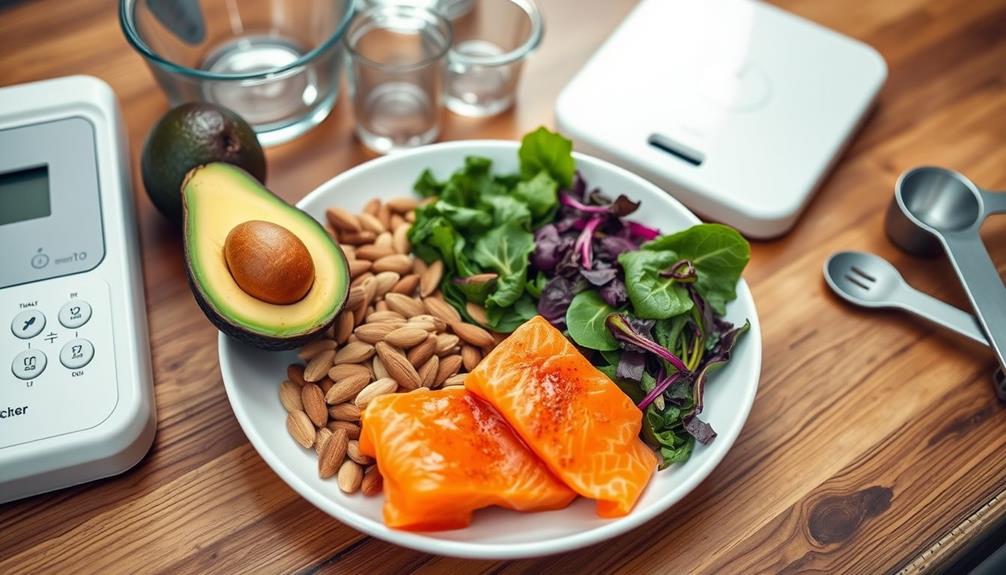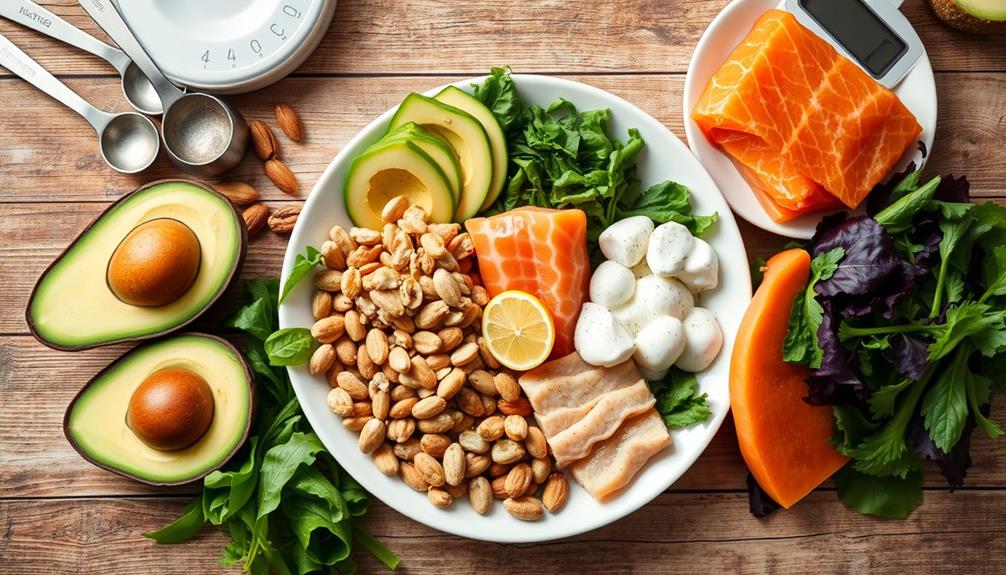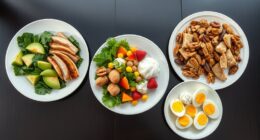Mastering your macronutrients is essential for keto success. Aim for 70-75% of your calories from healthy fats, 20-25% from protein, and only 5-10% from carbohydrates to stay in ketosis. Include nutrient-dense sources like avocados, grass-fed meats, and leafy greens to meet these targets. Track your intake with apps to guarantee you stay on track and adjust your ratios based on your health goals. Don't forget meal prep to avoid unhealthy choices and keep things interesting. There's a lot more to explore on tailoring your approach for the best results.
Key Takeaways
- Focus on a macronutrient ratio of 70-75% fats, 20-25% protein, and 5-10% carbohydrates to maintain ketosis effectively.
- Choose nutrient-dense foods like grass-fed meats, healthy fats, and low-carb vegetables to meet your macronutrient needs.
- Track your macronutrient intake using apps or food diaries to ensure adherence to your keto goals and make necessary adjustments.
- Experiment with various recipes and meal prep strategies to maintain variety and prevent boredom in your keto diet.
- Regularly evaluate and personalize your macronutrient ratios based on individual health goals and progress to optimize results.
Understanding Macronutrients

Often overlooked, understanding macronutrients is important for your success on a ketogenic diet. Macronutrients—carbohydrates, proteins, and fats—play significant roles in your body's functions.
In a keto diet, it's necessary to keep your carb intake low to maintain ketosis, typically aiming for just 5-10% of your total calories. Meanwhile, fats should make up 70-75% of your intake, serving as your primary energy source.
Don't forget about protein, which should constitute about 20-25% of your diet, supporting muscle repair and satiety. Tailoring these ratios based on your specific health goals—whether weight loss or muscle gain—will enhance your results.
Mastering these fundamentals sets the foundation for a successful ketogenic journey.
Essential Macronutrient Sources

Choosing the right sources for your macronutrients is crucial for keto success. For protein, prioritize grass-fed meats, wild-caught fish, and free-range eggs to fuel muscle repair and support satiety.
Healthy fats should come from avocados, olive oil, and nuts, as these provide the energy needed to maintain ketosis and overall cellular health.
When it comes to carbohydrates, focus on low-carb, fiber-rich vegetables like leafy greens and cruciferous veggies to guarantee you're still getting essential micronutrients without exceeding your carb limits.
Keto Meal Planning Strategies

After selecting nutrient-dense foods to meet your macronutrient ratios, effective meal planning becomes the next essential step in your keto journey.
Start by evaluating your nutritional needs and creating a structured menu that aligns with them. Choose versatile, keto-friendly ingredients to minimize waste and make grocery shopping easier.
Meal prep saves time and money—consider batch cooking meals like Chicken and Broccoli Alfredo for quick, satisfying options throughout the week.
Don't forget to portion your meals to maintain control over your intake. Incorporate a variety of recipes to keep things interesting and prevent boredom.
Tracking Your Macronutrient Intake

Tracking your macronutrient intake is essential for achieving and maintaining success on a ketogenic diet. By keeping a close eye on your carbs, fats, and proteins, you'll guarantee you stay within the ideal ratios of 70-75% fats, 20-25% protein, and 5-10% carbohydrates.
Incorporating a balanced diet rich in healthy fats and low in carbohydrates can further enhance your effective strategies for weight loss. Use apps, food diaries, or barcode scanners to simplify the tracking process.
Regularly reassess your intake, especially if you hit a weight stall or feel low on energy. Adjusting your diet based on these observations can help you prevent cravings and stay aligned with your health goals.
Common Keto Meal Prep Mistakes

Many people make common mistakes when it comes to keto meal prep that can derail their success. To avoid pitfalls, focus on these areas:
1. Planning Shortcomings: Skipping meal prep can lead to unhealthy last-minute choices and impulse eating.
Always plan your meals in advance to stay on track.
2. Lack of Variety: Eating the same meals repeatedly can cause boredom, making it harder to stick to your diet.
Experiment with different recipes and ingredients to keep things interesting.
3. Portion Control Issues: Ignoring portion sizes can lead to overeating, disrupting ketosis and your progress.
Measure your servings to maintain control over your caloric intake.
Effective Storage Techniques

To guarantee your keto meal prep supports long-term success, effective storage techniques play a key role. Proper storage keeps your meals fresh and compliant with keto guidelines. Here are some methods to evaluate:
| Storage Method | Benefits | Tips |
|---|---|---|
| Vacuum Sealing | Extends shelf life | Invest in a good vacuum sealer |
| Airtight Containers | Prevents moisture and odors | Label containers with dates |
| Freezing | Preserves nutrients | Portion meals before freezing |
| Refrigeration | Maintains freshness | Store in the main compartment |
| Glass Containers | Non-toxic and reusable | Choose BPA-free options |
Reheating Methods for Meal Prep

Reheating methods can greatly impact the quality and enjoyment of your keto meal prep. Choosing the right technique guarantees your meals are tasty and retain their nutritional value.
Here are three effective reheating methods to take into account:
- Microwave: This quick option is perfect for individual portions. Just cover your meal to prevent moisture loss and heat it in short intervals, stirring as needed.
- Oven: For baked dishes, preheat your oven to 350°F. This method evenly warms your food while keeping it crispy.
- Stovetop: Ideal for soups or sauces, use a low flame and stir frequently to prevent sticking and guarantee even heating.
Using these methods, you'll enjoy your delicious keto meals while maintaining their quality.
Personalizing Your Keto Journey

How can you make the ketogenic diet work best for you? Start by evaluating your individual goals, whether it's weight loss, muscle gain, or improved energy levels.
Adjust your macronutrient ratios to fit your lifestyle and preferences, ensuring you maintain the recommended 70-75% fats, 20-25% protein, and 5-10% carbohydrates.
Experiment with different foods to see what satisfies you and keeps you in ketosis. Track your intake using apps or journals, making it easier to identify patterns and adjust as necessary.
Don't hesitate to adjust your meal plans based on your progress and how you feel.
Frequently Asked Questions
Can I Eat Snacks on a Ketogenic Diet?
Yes, you can eat snacks on a ketogenic diet! Just choose low-carb options like nuts, cheese, or avocado. These snacks can help maintain your energy levels and keep you satisfied without disrupting your ketosis.
How Do I Know if I'm in Ketosis?
To know if you're in ketosis, monitor your energy levels, appetite changes, and ketone levels through urine strips or blood tests. You'll likely experience reduced cravings and increased energy when in ketosis.
What Are Ketone Bodies and Their Role in Keto?
Ketone bodies are produced during fat metabolism when your body lacks carbohydrates. They serve as an alternative energy source, fueling your brain and muscles, helping you maintain energy levels while adhering to a ketogenic diet.
Is Intermittent Fasting Compatible With a Keto Diet?
Yes, intermittent fasting's compatible with a keto diet. You can enhance fat burning and improve insulin sensitivity. Just verify you're meeting your macronutrient goals during eating windows to maintain ketosis and overall health.
How Do I Handle Dining Out on Keto?
When dining out, you've gotta channel your inner food detective. Scan menus for low-carb options, ask for modifications, and don't hesitate to swap sides. Enjoying meals while staying keto is totally doable with a little creativity!
Conclusion
In your ketogenic quest, mastering macronutrients means making mindful meal choices. By prioritizing powerful proteins and fabulous fats while minimizing mischievous carbs, you're setting yourself up for success. Stay savvy with meal planning, tracking, and avoiding common pitfalls to guarantee a smooth, satisfying journey. Remember, it's all about finding your flow and flavor, so embrace the adventure of personalizing your plate. With passion and persistence, you'll pave the path to keto success! Take charge of your ketogenic journey by incorporating keto meal prep into your routine. This will help you stay on track and avoid temptations when hunger strikes. By preparing your meals in advance, you can ensure that you always have delicious and nutritious options at your fingertips, making it easier to stick to your macros and reach your goals. So, roll up your sleeves and get ready to conquer the world of keto meal prep!









